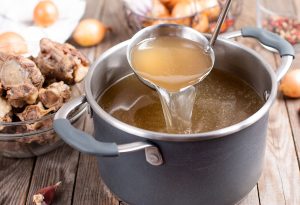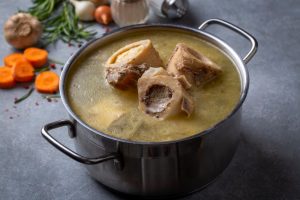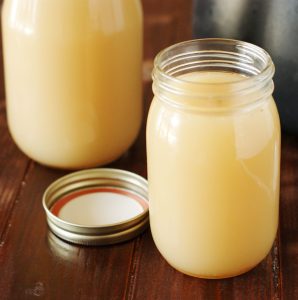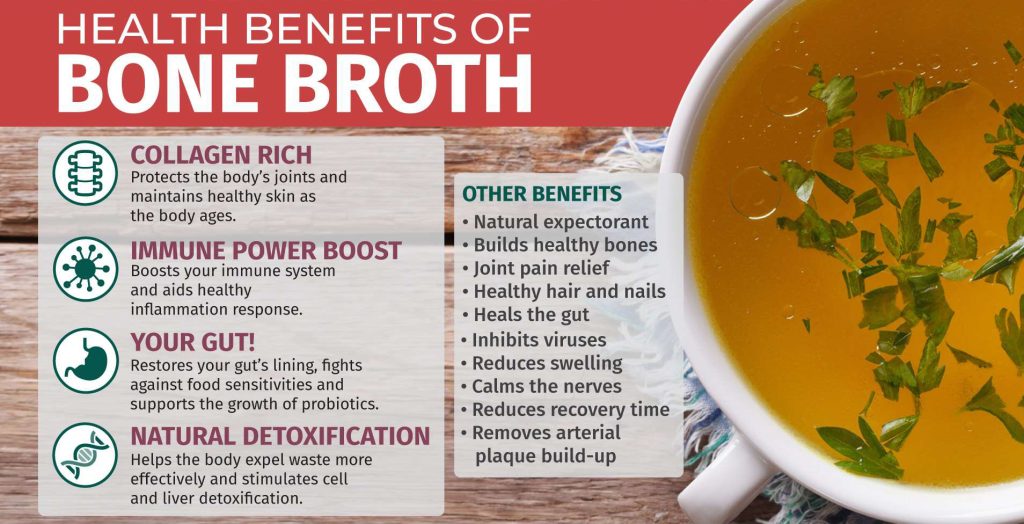What is Bone Broth?
 Bone broth is a nutritious liquid made by simmering animal bones and connective tissues in water for an extended period, often with added vegetables and seasonings. It is commonly used as a base for soups and sauces or consumed on its own for its health benefits.
Bone broth is a nutritious liquid made by simmering animal bones and connective tissues in water for an extended period, often with added vegetables and seasonings. It is commonly used as a base for soups and sauces or consumed on its own for its health benefits.
The longer you cook this nourishing broth, the more savory and concentrated it will become. Roasting the bones and vegetables beforehand will add even more flavor and richness. Season with salt and sip this restorative broth on its own, use it as a cooking liquid for grains or legumes, or deploy it as a base for sauces and soups. Hearty and healthy.
Restorative, nourishing, and filled with age-defying collagen, Homemade Bone Broth seems to be everywhere these days. Easy and versatile, Learn How to Make Bone Broth with my easy-to-follow instructions, tips, and answers to all your bone broth frequently asked questions.
What is the difference between bone broth and stock?
The short answer- bone broth is essentially the hip and trendy new name for stock.
Traditional Stock is more gelatinous when cool. Stock is typically cooked for long periods of time with marrow-rich bones which contribute to the viscous, gelatinous texture when cold.
Traditional Broth, on the other hand, is typically thinner as it contains much less, if any, collagen. Broth is made from boiling actual meat, and less from marrow-rich bones.
Bone Broth Benefits
With its sudden rise in popularity, there has been a nonstop buzz all about the miracle health benefits of bone broth. While there is plenty of evidence to suggest these benefits to be true, there is no published research confirming this to be true or false. Full disclosure.
Vitamins and minerals. This will vary depending on the type of animal source you use, but for this broth recipe, you’ll find loads of calcium, magnesium, potassium, and phosphorus, Vitamin A, K2, and minerals like zinc, iron, boron, manganese, and selenium.
Glucosamine and chondroitin. Natural compounds found in connective tissue which supports joint health. Collagen. And lots of it. This turns into gelatin that, when cooked, yields several important amino acids.
Helps maintain digestive health. Bone broth is not only easy to digest, but it may also help in the digestion of other food. Gelatin binds to the water in your digestive tract, helping food move through your gut easier. It is also believed to help with a condition called “leaky gut” or other inflammatory bowel diseases.
Suggested to help fight inflammation. The amino acids glycine and arginine have strong anti-inflammatory effects. Chronic inflammation may lead to a number of serious diseases such as heart disease, diabetes, metabolic syndrome, arthritis, and types of cancer.
May improve joint health.
Recipe
Ingredients
- 10 pounds beef bones – preferably a mix of marrow bones (femur bones) and bones with meat on them (oxtail, short ribs, and knuckle bones cut in half)*
- 2 tablespoons of apple cider vinegar (helps to pull nutrients from the bones)
- 4 large carrots – chopped into 2-inch pieces
- 2 medium onions – quartered
- 2 whole heads garlic – halved crosswise (can use fresh garlic scapes as a substitute)
- 6 stalks celery – cut into 2-inch pieces
- 4 bay leaves
- 1/4 cup black peppercorns
- add kale, stinging nettle, or any other goodie from your garden.
Instructions
Blanch the bones. Divide the bones between two large stockpots and cover with cold water. Bring to a boil over high heat and simmer for 15-20 minutes before draining and rinsing the bones with water.
Roast the bones and the vegetables. Ok, so the bones have been blanched. Now, preheat the oven to 450 degrees F. Transfer the bones and vegetables (carrots, onions, garlic, celery) to the roasting pans. Don’t pile them all on top of each other- use two roasting pans. Roast for 30 minutes before gently tossing the bones and vegetables, and roasting for an additional 15-30 minutes more.
Transfer the bones back to the stockpots. But not before washing the stockpots first. Make sure you wash your pots after the bones were blanched and drained. Transfer the bones back to the stock pots and scrape up any remaining bits and juices remaining in the roasting pan using a metal spatula and a little water, if needed. Transfer to the pot with the bones (don’t worry, all those brown bits are FLAVOR!).
Boil the bones. With the bones and vegetables divided between the two pots divide the bay leaves, peppercorns, star anise, cinnamon sticks, and apple cider vinegar between the two pots. Fill each pot with approximately 12 cups water, or until bones are fully submerged. Cover the pots and bring to a low and gently boil.
Simmer the bones. Reduce heat to low and simmer, with the lid slightly ajar, skimming any foam or excess fat, occasionally. Simmer for at least 8-12 hours, ideally 24 hours (do not leave the stove running overnight. Simply cool and store in the refrigerator and continue to simmer the next day). Add more water if needed to make sure bones and vegetables remain fully submerged.
Strain the bones. Once the bones have simmered and your broth is ready, you will need to strain the broth through a fine mesh strainer. Set aside the broth to cool and allow the bones to cool.
Don’t forget about the meat. Whether you eat the meat still left on the bones in a bowl of soup or in sandwiches, I can almost guarantee that there is a TON of delicious meat waiting to be picked from the bones. Don’t let it go to waste! Discard the meat-free bones and vegetables.
Skim the fat from your broth (optional). Add a couple handfuls of ice to your beef broth to expedite cooling and cover with a lid. Transfer broth to the refrigerator and allow broth to cool fully. The result will be a hard, thick layer of fat and a bottom layer that is your bone broth (which should look like gelatinous brown jello). If desired use a fork to scoop off the top layer of fat. This will leave behind the healthy bone broth, minus the fat.
Store your bone broth in jars for future use. Bone broth stores well in the refrigerator for approximately 5 days. If you make a large batch, I recommend freezing smaller batches in the freezer for up to 6 months (it reheats perfectly!).
Nutritional Facts
- Calories: 45kcal
- Carbohydrates: 0g
- Protein: 11g
- Fat: 0g
- Saturated Fat: 0g
- Cholesterol: 0mg
- Sodium: 0mg
- Potassium: 2mg
- Fiber: 0g
- Sugar: 0g
- Vitamin C: 0mg
- Calcium: 4mg
- Iron: 0.1mg
(Nutrition information provided is an estimate and will vary based on cooking methods and specific brands of ingredients used.)
Note: the nutritional information was based on the information that a 1/2-ounce serving of beef bone marrow contains 125.59 calories. Given that I used a mixture of different bones, chilled the broth and removed the fatty top layer, it is likely that this soup much lower in calories. Unfortunately, I lack the tools needed for an exact calculation.
Health Benefits of Bone Broth
Source: Healthline.com
1. It contains vitamins and minerals
Bone broth can be nutritious, but the precise nutritional content will depend on the bones you use.
- Animal bones are rich in calcium, magnesium, and other vitamins and minerals needed to build and strengthen your own bones. However, only small amounts of these nutrients — less than 5% of daily value — actually make it into the broth.
- Marrow provides minerals like calcium and phosphorus and very small amounts of vitamins A, B, K, and E.
- All these parts also contain the protein collagen, which turns into gelatin when cooked and yields several important amino acids.
Simmering the ingredients releases some of their nutrients into the water in a form your body can easily absorb.
2. It may benefit the digestive system
A healthy digestive tract is essential for well-being. Bone broth is easy to digest and may help reduce inflammation in the digestive tract.
Gelatin from bone broth contains an amino acid called glutamic acid. This converts to glutamine in the body and helps maintain the function of the intestinal wall. It may help prevent and heal a condition known as “leaky gut,” a symptom of several chronic gastrointestinal diseases.
A leaky gut is when damage occurs between the barrier between your gut and the bloodstream, allowing substances to leak from your gut into your bloodstream. This can lead to inflammation and other problems.
3. It may help fight inflammation
The amino acids found in bone broth, including glycine and arginine, have anti-inflammatory properties. Chronic inflammation has been linked to various serious diseases, such as heart disease, diabetes, arthritis, and cancer. Including anti-inflammatory foods in the diet, such as bone broth, may help reduce the risk of these diseases.
4. Its nutrients may improve joint health
Collagen is the main protein found in bones, tendons, and ligaments. While cooking bone broth, collagen from bones and connective tissue breaks down into another protein called gelatin.
Gelatin found in bone broth contains important amino acids that support joint health. These include proline and glycine, which your body uses to build its own connective tissue. Connective tissue is the main component of tendons, which connect muscles to bones, and ligaments, which connect bones to each other.
5. Weight management and muscle mass
Bone broth is typically low in calories, but it can still satisfy hunger. There is some evidence that people who consume soups are less likely to develop obesity. This suggests that soups may play a role in managing weight.
Bone broth is high in protein, and some evidence suggests a high protein diet can also help manage weight, as it is satisfying and can help a person feel full.
6. It may improve sleep and brain function
The amino acid glycine, found in bone broth, may help you relax. Some research has suggested that glycine may help promote sleep. Drinking bone broth before bed helped participants:
- fall asleep faster
- maintain a deeper sleep
- wake up fewer times throughout the night
Source: Healthline.com



